UNBELIEVABLY GREAT ANDEAN PONCHO Rare Antique Indian Beaded Textile TM4475

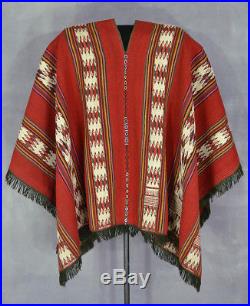
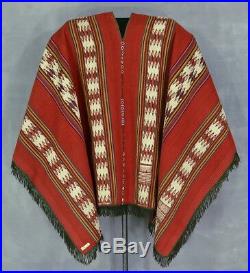
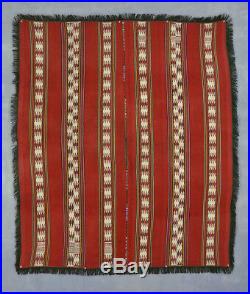
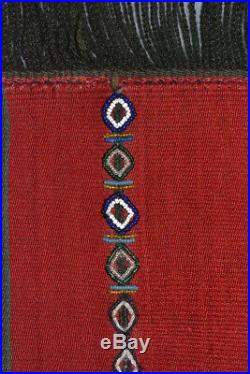
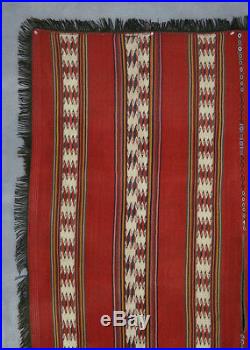
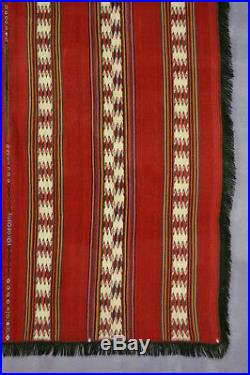
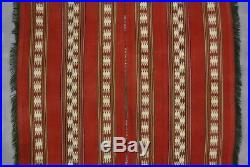
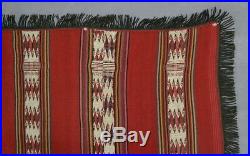
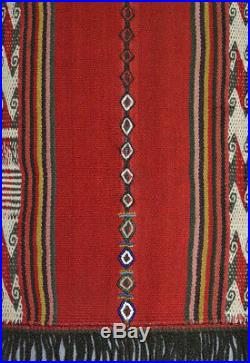

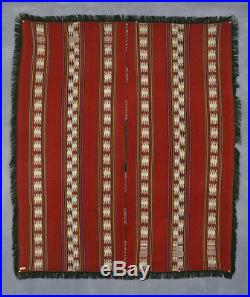

AN INCOMPARABLE HISTORIC KALLAWAYA INDIAN PONCHO FROM THE SOUTH AMERICAN ANDES. Origin: Niñu Kurin Village (also Niño Corin and Niño Korin), elevation about 11,000 feet, Curva Municipality (formerly Cantón Curva), Apolobamba Mountain Range, Bautista Saavedra Province, Department of La Paz, Bolivia, South America. Background and Description: This is an exceptionally beautiful, rare and valuable Andean Indian poncho from the greater Kallawaya village of Niñu Kurin (Niño Corin) near the junction of the Eastern (Oriental) and Western (Occidental) Andean cordilleras. This ceremonial phista , or kurti punchu has the following characteristics. The poncho was expertly hand-woven in two identical halves on a staked, provisional loom, of a kind first used prehistorically. The well-prepared, all-handspun wool consists of alpaca, huarizo (llama and alpaca mixed breed) and sheep. Some natural dyes were employed and all dyes were expertly processed with superb mordants. The field color is a beautiful, very uncommon rust tone. The poncho is woven with special magic designs, called kurti in Kallawaya. It measures 63 by 54 inches, including two-inch peripheral fringe. The piece was very finely woven with 54 warps and 15 wefts per inch. The lateral rust-colored bands are enhanced with four stripes of reverse spun yarn creating fine herringbone patterns. This Andean spinning/weaving technique is called lluq´i and was added to protect the wearer from malignant energies. The center seam was elaborately decorated on both sides with rows of historic Venetian glass trade beads in smart diamond patterns. The beads date from circa 1870 to 1900. The poncho is in EXCELLENT, superb condition with very minor loss to a few strands of tightly twisted fringe. For further information and details on. The poncho´s condition, spiritual importance, exact materials, weaving technology, cultural attribution, etc. PLEASE WRITE and we´ll be happy to send or include those details. A personal note from L. This is among the oldest of known Kallawaya textiles. The original, unique beadwork is amazing; glass trade beads were considered powerful medicine to the Kallawaya. One of our Kallawaya shamanic informants, Braulio L. Commented quite emotionally on the extraordinary and profuse use of special magic designs in the poncho and suggested that the textile was woven for an extremely eminent tribal shaman. This is undoubtedly one of the most important and awe-inspiring indigenous ponchos to have originated from the Andes. – ESTIMATED ARRIVAL TIME 3-4 DAYS. The disadvantage is that items will not arrive quickly. Items to the United States of America have arrived in as few as ten days. Our offices are not in close proximity to international postal service. We promise to continue providing detailed and accurate information related to age, origin, condition and descriptions as we have for the past 15 years. ANDES AMAZON “DATING” TERMS. PREHISTORIC, PRE-COLUMBIAN, ANCIENT = Before around A. 18TH CENTURY = A. 19th CENTURY = 1800 to 1899. TURN OF THE 19TH CENTURY = 1890 to 1910. EARLY-20TH CENTURY = 1900 to 1933. MID-20TH CENTURY = 1934 to 1966. LATE-20TH CENTURY = 1967 to 1999. TURN OF THE 20TH CENTURY = 1995 to 2005. EARLY-21ST CENTURY = 2000 to Present. ANTIQUE = Over 50 years old. VINTAGE = Over 30 years old. CONTEMPORARY = Made in the last 5 years. CIRCA = Approximately/around/within a few years of. ANDES AMAZON TEXTILE CONDITION TERMS. Terms used to describe the physical condition of textiles can be subjective and vary greatly from one observer to another. What some others call mint condition, we call good; what others call excellent condition, we call fair. Following are explanations of the terms we use. MINT = Like new. Unused — as if recently removed from the loom. No wear or patina of any kind. These textiles may have nubs or even loose, uncut threads from the weaving process. EXCELLENT = Usually only lightly used, often guarded or stored for many years. There may be extremely light wear, patina and sheen from use. There may also be nearly undetectable light staining or soiling from use. The colors may have muted ever so slightly due to age or exposure, often improving the beauty of a textile. VERY GOOD = Usually lightly or only periodically used. The surface may be very lightly but evenly worn. There are no tears or distracting holes. There may be minimal surface discoloration. Vintage textiles may have lightly darkened yarn from use and age (staining and soiling). Overall, the textile will be in outstanding condition and at a displayable distance will appear perfect. GOOD = Usually moderately to well-used. There may be light to medium staining, isolated or throughout. Some parts of the textile may be worn or have very small holes, occasionally exposing hidden thread yarns. Edges may be lightly frayed. Surface discoloration due to age and exposure is common but often improving the appearance of a textile. There may be minor, light or isolated, dye run. Damage will not distract significantly from the textile when displayed. FAIR = Either well-used or moderately abused. Extensive wear is common as is some bleeding or dye run. In most 20th century cases, the colors have considerably faded. Sections of fringe or tassels may be missing. Textiles may be in otherwise excellent condition but with a single isolated sector of damage, that greatly reduces its aesthetic appeal. Most vintage tribal textiles on the market are in FAIR TO GOOD condition. POOR = Showing evidence of extreme usage and damage. These textiles do not display well and are primarily useful as study specimens or examples of sometimes very rare textiles. We believe the world can be a better place. We believe that humanity has a higher, aspiring destination. We know that through mutual respect conflicts will subside. We know that by understanding our differences we can help one another. We believe that our Mother Earth and our Universe can provide unlimited resources for every man, woman and child to live in peace, happiness and love. As stewards of the human race we have an intrinsic responsibility to do what we can to improve our world as much as possible. The majority of human existence has been dominated by so-called Native groups, also known as tribal folk, original residents, indigenous people, aboriginals, First Nations, traditional ethnicities, autochthonous societies, autochthonal cultures, et. At some point of course our ancestors were the same regardless of current culture, creed or color. Regrettably, in the past half a millennium, thousands of unique tribal groups have disappeared due to misunderstanding, impudence and ethnocentrism. Aspects of colonialism, capitalism, racism and politicization have directly and circuitously destroyed myriad native cultures, each a once-valuable resource to our planet. Of the nearly 7000 languages currently spoken on our planet, over 6000 are in immediate danger of becoming extinct. The vast majority of those are ethnic indigenous. We believe the very few Native groups that remain on earth should be cherished and carefully supported. Unfortunately, we are on the brink of losing our connection with indigenous spirit, wisdom and traditional knowledge. For more than a quarter century those of us behind AKATAKSA/ANDESAMAZON have dedicated our professional interests to documenting traditional South American indigenous cultures, especially through their material culture. Our field studies have led us to some of the remote people on the continent. We have witnessed Native Americans existing exactly as their ancestors did in prehistoric times and others who have jumped from 18th century existence to 21st century reality in the blink of an eye. Our ethnographic investigations have resulted in valuable data related to linguistics, cultural history, ethno-environmental relationships, socio-cultural organization, cosmology, mythology, spirituality and of course, material culture. We have a detailed proposal for a magnificent cultural center aimed at stimulating interest in past and present indigenous cultures. Our unique idea is not just to show beautiful objects on display. Ours is to share the entire background of a piece, not only from a scientific or scholarly point of view but also from a cultural and spiritual perspective as well. This holistic approach to understanding indigenous material culture shall include accompanying photographs, films, recorded testimonials, music, related specimens and even field notes. We want to inspire our visitors to continue their own investigations into realms of mysterious phenomena that we really know very little about. Apart from receiving monies for researching indigenous material culture, our sales contribute toward expanding interest in past cultures and ways of life. Not only can ones´ personal environment be enhanced with beautiful and interesting objects but the benefits of knowing about different ideologies, unique ways of life and past or nearly-extinct traditions are utterly invaluable. We hope that whatever understanding, knowledge and insights are obtained from our objects will be shared with companions, friends and especially children. In this small way we feel inspired in preserving something of native cultures and making the world a better place. Thank you for working with us. THANK YOU FOR YOUR INTEREST AND SUPPORT. The item “UNBELIEVABLY GREAT ANDEAN PONCHO Rare Antique Indian Beaded Textile TM4475″ is in sale since Sunday, July 1, 2018. This item is in the category “Antiques\Ethnographic\Native American”. The seller is “andesamazon” and is located in Santa Cruz, . This item can be shipped worldwide.
